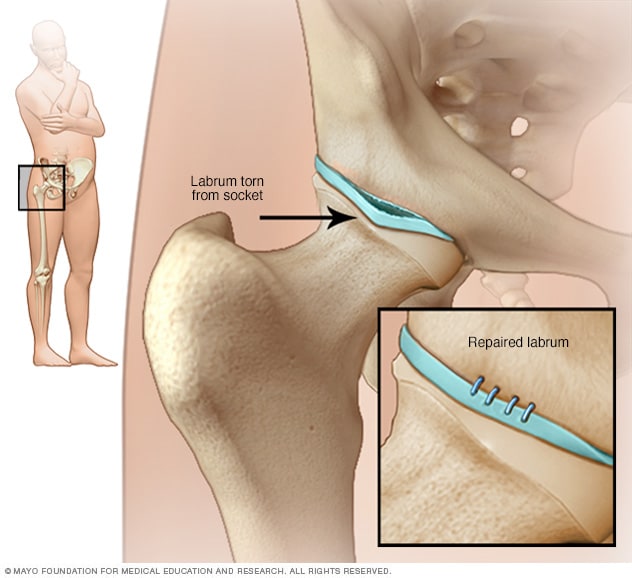Hip labral tear
Overview
A hip labral tear involves the ring of cartilage (labrum) that follows the outside rim of the hip joint socket. Besides cushioning the hip joint, the labrum acts like a rubber seal or gasket to help hold the ball at the top of the thighbone securely within the hip socket.
Athletes who participate in sports such as ice hockey, soccer, football, golf and ballet are at higher risk of developing hip labral tears. Structural problems of the hip also can lead to a hip labral tear.

Symptoms
Many hip labral tears cause no signs or symptoms. Some people, however, have one or more of the following:
- Pain in the hip or groin, often made worse by long periods of standing, sitting or walking or athletic activity
- A locking, clicking or catching sensation in the hip joint
- Stiffness or limited range of motion in the hip joint
When to see a doctor
Seek medical attention if symptoms worsen or don't improve within six weeks.
Causes
The cause of a hip labral tear might be:
- Trauma. Injury to or dislocation of the hip joint — which can occur during car accidents or from playing contact sports such as football or hockey — can cause a hip labral tear.
-
Structural problems. Some people are born with hip issues that can accelerate wear and tear of the joint and eventually cause a hip labral tear. This can include having a socket that doesn't fully cover the ball portion of the upper thigh bone (dysplasia) or a shallow socket, which can put more stress on the labrum.
Extra bone in the hip, called femoroacetabular impingement (FAI), can also cause pinching of the labrum, which can lead to tearing over time.
- Repetitive motions. Sports-related and other physical activities — including long-distance running and the sudden twisting or pivoting motions common in golf or softball — can lead to joint wear and tear that ultimately result in a hip labral tear.
Risk factors
Anyone can get a hip labral tear, but certain conditions and activities increase the risk.
People with structural problems in the hip such as impingement, dysplasia or loose ligaments are more likely to develop a hip labral tear over time.
Participating in certain activities that involve repetitive or twisting motions can increase the risk of a hip labral tear. These include sports such as ballet, golf and swimming. Playing contact sports such as football and hockey also increase the risk of hip injuries, including hip labral tears.
Complications
A hip labral tear can make it more likely that you'll develop osteoarthritis in that joint.
Prevention
If the sports you play put a lot of strain on your hips, condition the surrounding muscles with strength and flexibility exercises.
Diagnosis
Your health care provider will take a history of your discomfort. The physical exam will likely involve moving your leg, and especially your hip joint, into various positions to check for pain and evaluate your hip's range of motion. He or she might also watch you walk.
Imaging scans
A hip labral tear rarely occurs by itself. In most cases, other structures within the hip joint also have injuries. X-rays are excellent at visualizing bone. They can check for arthritis and for structural problems.
A magnetic resonance arthrography (MRA) can provide detailed images of your hip's soft tissues. MRA combines MRI technology with a contrast material injected into the hip joint space to make a labral tear easier to see.
Anesthesia injection
Hip pain can be caused by problems within the joint or outside the joint. Your health care provider might suggest injecting an anesthetic into the joint space. If this relieves your pain, it's likely that your problem is inside your hip joint.
Treatment
Treatment depends on how severe your symptoms are. Some people recover in a few weeks with conservative treatments, including rest and modified activities; others need arthroscopic surgery to repair the torn portion of the labrum.
Medications
Nonsteroidal anti-inflammatory drugs, such as ibuprofen (Advil, Motrin IB, others) and naproxen sodium (Aleve), can relieve pain and reduce inflammation. Pain can also be controlled temporarily with an injection of corticosteroids into the joint.
Therapy
A physical therapist can teach you exercises to increase your hip's range of motion and build hip and core strength and stability. Therapists can also teach you to avoid movements that put stress on your hip joint.
Surgical and other procedures
If conservative treatments don't relieve your symptoms, your health care provider might recommend arthroscopic surgery — in which a fiber-optic camera and surgical tools are inserted via small incisions in your skin.
Depending on the cause and extent of the tear, the surgeon might remove the torn piece of labrum or repair the torn tissue by sewing it back together.
Complications of surgery can include infection, bleeding, nerve injury and recurrent symptoms if the repair doesn't heal properly. A return to sports usually takes 3-6 months.
Preparing for your appointment
Your health care provider might refer you to a doctor who specializes in hip disorders or sports medicine.
What you can do
Make a list that includes:
- Detailed descriptions of your symptoms and when they began
- Other medical problems you've had
- Activities that might contribute to your hip pain
- All medications, vitamins and other dietary supplements you take, including doses
- Questions to ask the health care provider
What to expect from your doctor
Your health care provider might ask:
- Where exactly is your pain?
- What were you were doing when it started?
- Does anything make the pain better or worse?
Last Updated Feb 5, 2022
© 2024 Mayo Foundation for Medical Education and Research (MFMER). All rights reserved. Terms of Use



